Alexander Nevsky
| Alexander Nevsky | |
|---|---|
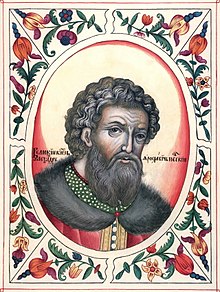 Portrait in the Tsarsky titulyarnik, 1672 | |
| Prince of Novgorod | |
| Reign | 1236–1240 |
| Predecessor | Yaroslav V |
| Successor | Andrey I |
| Reign | 1241–1256 |
| Predecessor | Andrey I |
| Successor | Vasily I |
| Reign | 1258–1259 |
| Predecessor | Vasily I |
| Successor | Dmitry I |
| Grand Prince of Kiev | |
| Reign | 1246–1263 |
| Predecessor | Yaroslav III |
| Successor | Yaroslav IV |
| Grand Prince of Vladimir | |
| Reign | 1252–1263 |
| Predecessor | Andrey II |
| Successor | Yaroslav III |
| Born | 13 May 1221 Pereslavl-Zalessky, Vladimir-Suzdal |
| Died | 14 November 1263 (aged 42) Gorodets, Vladimir-Suzdal |
| Burial | Alexander Nevsky Lavra, Saint Petersburg, Russia |
| Spouse | Paraskeviya (Alexandra) of Polotsk Vasilisa (Vassa) |
| Issue | Vasily Alexandrovich Eudoxia Alexandrovna Dmitry Alexandrovich Andrey Alexandrovich Daniil Alexandrovich |
| House | Yurievichi |
| Father | Yaroslav II of Vladimir |
| Mother | Feodosia Igorevna of Ryazan |
| Religion | Eastern Orthodox |
Alexander Yaroslavich Nevsky[1] (Russian: Александр Ярославич Невский; IPA: [ɐlʲɪˈksandr jɪrɐˈsɫavʲɪtɕ ˈnʲɛfskʲɪj] ; monastic name: Aleksiy;[2] 13 May 1221[3] – 14 November 1263) was Prince of Novgorod (1236–1240; 1241–1256; 1258–1259), Grand Prince of Kiev (1246–1263) and Grand Prince of Vladimir (1252–1263).
Commonly regarded as a key figure in medieval Russian history,[4] Alexander was a grandson of Vsevolod the Big Nest and rose to legendary status on account of his military victories over Swedish invaders, specifically the Battle of the Neva[a] and the Battle on the Ice. He preserved separate statehood and Orthodoxy, agreeing to pay tribute to the powerful Golden Horde. Metropolitan Macarius of Moscow canonized Alexander Nevsky as a saint of the Russian Orthodox Church in 1547.[5]
Early life
[edit]From the Tales of the Life and Courage of the Pious and Great Prince Alexander found in the Second Pskovian Chronicle (c. 1260–1280) comes one of the first known references to Alexander Yaroslavich:[6]
By the will of God, prince Alexander was born from the charitable, people-loving, and meek the Great Prince Yaroslav, and his mother was Theodosia. As it was told by the prophet Isaiah: 'Thus sayeth the Lord: I appoint the princes because they are sacred and I direct them.'
...He was taller than others and his voice reached the people as a trumpet, and his face was like the face of Joseph, whom the Egyptian Pharaoh placed as next to the king after him of Egypt. His power was a part of the power of Samson and God gave him the wisdom of Solomon... this Prince Alexander: he used to defeat but was never defeated...
Born in Pereslavl-Zalessky, Alexander was the second son of Prince Yaroslav Vsevolodovich and Feodosia Igorevna of Ryazan. His maternal grandfather was Igor Glebovich, the second son of Gleb Rostislavich, the prince of Ryazan (d. 1178). His maternal grandmother was Agrafena of Kiev, daughter of Rostislav I of Kiev.[citation needed]
Reign
[edit]Prince of Novgorod
[edit]
In 1236, Alexander was appointed by the Novgorodians to become their prince (knyaz), where he had already served as his father's governor in Novgorod.[7]
In 1237, the Swedes received papal authorization to launch a crusade, and in 1240, new campaigns began in the easternmost part of the Baltic region.[8] According to the Novgorod First Chronicle written in the 14th century, more than a century after the events it records, the Swedish army landed at the confluence of the rivers Izhora and Neva, when Alexander and his small army suddenly attacked the Swedes on 15 July 1240 and defeated them at the Battle of the Neva. Following the battle, Alexander received the sobriquet Nevsky ("of the Neva").[9] This victory, coming just three years after the disastrous Mongol invasions, strengthened Alexander's political influence, but at the same time it worsened his relations with the boyars. Alexander would be banished to Pereslavl-Zalessky.[10]
Later in 1240, crusaders from the Bishopric of Dorpat along with the forces of the exiled prince of Pskov attacked the Pskov Republic and Votia, a tributary of Novgorod.[10] The Novgorodian authorities recalled Alexander, and in the spring of 1241, he returned from exile and assembled an army. Alexander managed to retake Pskov and Koporye from the crusaders and drive out the invaders.[11] He then continued into Estonian-German territory.[10] The crusaders defeated a detachment of the Novgorodian army about 20 kilometres (12 mi) south of the fortress of Dorpat. As a result, Alexander set up a position at Lake Peipus.[10] Alexander and his men then faced the Livonian heavy cavalry led by Hermann of Dorpat, brother of Albert of Buxhoeveden, where they met on 5 April 1242.[10] Alexander's army then defeated the enemy in the Battle on the Ice, halting the eastward expansion of the Teutonic Order.[12] Later Russian sources would elevate the importance of the battle and portray it as one of the great Russian victories of the Middle Ages.[13]
After the Livonian invasion, Nevsky continued to strengthen the Republic of Novgorod. He sent his envoys to Norway and, as a result, they signed a first peace treaty between Novgorod and Norway in 1251. Alexander led his army to Finland and successfully routed the Swedes, who had made another attempt to block the Baltic Sea from the Novgorodians in 1256.[14]
Grand Prince of Vladimir
[edit]Upon the conquest of the Grand Principality of Vladimir by the Mongols in 1238,[15] its reigning prince, Yuri II Vsevolodovich, was killed in the Battle of the Sit River; his younger brother, Yaroslav II Vsevolodovich (Alexander's father), requested and received from the Mongol khan his permission to become the new prince. As prince, he assigned Novgorod to his son Alexander. However, while traveling in 1245 to the Mongol capital Karakorum in Central Asia, Yaroslav died. When in 1248 Alexander and his older brother Andrey II Yaroslavich also traveled to Karakorum to attend upon the Great Khan, Andrey returned with the award of the title of grand prince of Vladimir and Alexander the nominal lordship of Kiev.[15]
The Rurikid princes of Rus' were obliged to appear before the khan in person to be affirmed in their principalities.[16] When Möngke became the new great khan in 1251, only two years after Guyuk's death, he demanded another appearance at Sarai on the Volga, but Andrey refused to go.[17] Thanks to his friendship with Sartaq Khan, the subsequent invasion by the Mongols, their first venture into northeastern Rus' since the initial conquest, saw Andrey exiled to Sweden and Alexander assuming the title of grand prince of Vladimir in 1252,[18] the most senior of the princes at the time following the fall of Kiev.[19] Alexander faithfully supported Mongol rule within his own domains. In 1259, he led an army to the city of Novgorod and forced it to pay tribute it had previously refused to the Golden Horde.[20]
Some historians see Alexander's choice of subordination to the Golden Horde as an important reaffirmation of East Slavs' Orthodox orientation (which begun under Vladimir I of Kiev and his grandmother Olga).[21] Orlando Figes mentions that "Nevsky's collaboration was no doubt motivated by his distrust of the West, which he regarded as a greater threat to Orthodox Russia than the Golden Horde".[19]
Death and burial
[edit]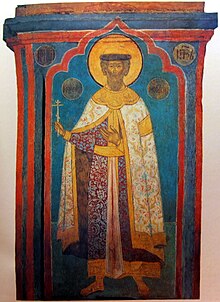
On 14 November 1263, while returning from Sarai on one of his frequent visits to the Horde, Alexander died in the town of Gorodets-on-the-Volga. On 23 November 1263, he was buried in the church of the Monastery of the Nativity of the Holy Mother of God in Vladimir.[22]
From the Second Pskovian Chronicle:[6]
Returning from the Golden Horde, the Great Prince Alexander, reached the city of Nizhny Novgorod, and remained there for several days in good health, but when he reached the city of Gorodets he fell ill...
Great Prince Alexander, who was always firm in his faith in God, gave up this worldly kingdom ... And then he gave up his soul to God and died in peace on 12 November [1263], on the day when the Holy Apostle Philip is remembered...
At this burial Metropolitan Archbishop Cyril said, 'My children, you should know that the sun of the Suzdalian land has set. There will never be another prince like him in the Suzdalian land.'
And the priests and deacons and monks, the poor and the wealthy, and all the people said: 'It is our end.'
Veneration and sainthood
[edit]Saint Alexander Nevsky | |
|---|---|
 | |
| Grand Prince of Vladimir | |
| Venerated in | Eastern Orthodox Church |
| Canonized | 1547 by Metropolite Macarius |
| Major shrine | Vladimir; Pereslavl-Zalessky, Saint Petersburg |
| Feast | 23 November (Repose) 2 May (Synaxis of the Saints of Rosand Yaroslavl) 30 August (Translation of relics) |
| Patronage | Russian Ground Forces and Russian Naval Infantry |
The veneration of Alexander began almost immediately after his burial, when he reportedly extended his hand for the prayer of absolution.[22] According to Orthodox tradition, Alexander foresaw his death and before this took strict Orthodox Christian monastic vows, called Great Schema, and took the name Alexey.
In 1380, Alexander's remains were uncovered in response to a vision before the Battle of Kulikovo and found to be incorrupt. The relics were then placed in a shrine in the church. Alexander was canonized as a saint of the Russian Orthodox Church by Metropolitan Macarius in 1547.[22]
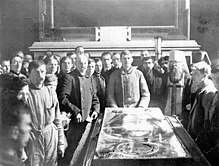
In 1695, a new wooden reliquary was made in Moscow, and the relics were placed in it in 1697.[22] By order of Peter the Great, the relics were then removed from Vladimir on 11 August 1723 and transported to Shlisselburg, arriving there on 20 September.[22] There they were kept until 1724, when they were brought to Saint Petersburg and installed in the Annunciation Church of the Alexander Nevsky Lavra on 30 August.[22]
In 1753, a silver shrine with sarcophagus for the relics, made with 90 pounds of silver, was donated by Empress Elizabeth of Russia. With the completion of the Holy Trinity Cathedral of the Alexander Nevsky Lavra in 1790, the shrine and relics were transferred there at its consecration on 30 August, one of the saint's feast days.[22]
In May 1922, during the general confiscation of Russian Orthodox Church property, the sarcophagus was opened and the relics removed;[23] and the elaborate silver shrine was transferred to the Hermitage Museum.[23] The relics were put into storage at the Museum of the History of Religion and Atheism, before being returned to the Holy Trinity Cathedral in 1989.[23] On 10 May 2023, the Hermitage Museum and Alexander Nevsky Lavra signed a contract for the transfer of the shrine to Holy Trinity Cathedral of the Alexander Nevsky Lavra for a period of 49 years.[24] On 12 September 2023, Patriarch Kirill of Moscow placed the relics back into the silver sarcophagus.[25]
Alexander's principal feast day is 23 November. A second feast day was instituted on 30 August in commemoration of the placing of his relics in the Annunciation Church. He is also commemorated in common with other saints of Rostov and Yaroslavl on 23 May.
In February 2024, it was announced that the memory of Saint Alexander Nevsky had been removed from the synaxarion used by the Orthodox Church of Ukraine.[26]
Marriage and children
[edit]According to the Novgorod First Chronicle, Alexander married first a daughter of Bryacheslav Vasilkovich, Prince of Polotsk and Vitebsk, in 1239. Her name is not given in the chronicle. Genealogies name her as Paraskeviya or Alexandra (possibly birth and marital names respectively). They had five children:
- Vasily Alexandrovich, Prince of Novgorod (c. 1239–1271). He was betrothed to Princess Kristina of Norway in 1251. The marriage contract was broken. Kristina went on to marry Felipe of Castile, a son of Ferdinand III of Castile and Elisabeth of Hohenstaufen.
- Eudoxia Alexandrovna. Married Konstantin Rostislavich, Prince of Smolensk.
- Dmitry of Pereslavl (c. 1250–1294).
- Andrey of Gorodets (c. 1255 – 27 July 1304).
He married a second wife named Vasilisa or Vassa[27] shortly before his death. They had one son.
- Daniel of Moscow (1261 – 4 March/5 March 1303).[28]
Legacy
[edit]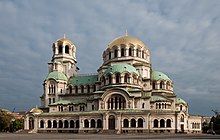
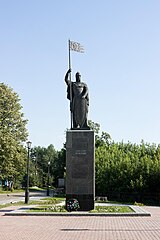
Some of Alexander's policies on the Western border were continued by his grandson-in-law, Daumantas of Pskov, who was also beatified in the 16th century. In the late 13th century, a chronicle was compiled called the Life of Alexander Nevsky (Житие Александра Невского), in which he is depicted as an ideal prince-soldier and defender of Russia.
On 21 May 1725, the empress Catherine I introduced the Imperial Order of St. Alexander Nevsky as one of the highest decorations in the land. During World War II, on 29 July 1942, the Soviet authorities introduced an Order of Alexander Nevsky to revive the memory of Alexander's struggle with the Germans. There was also an earlier Bulgarian Order dedicated to Saint Alexander which was founded on 25 December 1881, which ceased to exist when the People's Republic was declared on 16 September 1946.
In 1938, Sergei Eisenstein made one of his most acclaimed films, Alexander Nevsky, about Alexander's victory over the Teutonic Knights. The soundtrack for the film was written by Sergei Prokofiev, who also reworked the score into a concert cantata. Today the film is renowned for its extraordinary battle on ice sequence, which has served as inspiration for countless other films. In the picture, Nevsky used a number of Russian proverbs, tying Nevsky firmly to Russian tradition.[29] The famous proverbial phrase (paraphrasing Matthew 26:52), "Whoever will come to us with a sword, from a sword will perish," is a phrase that is often attributed to Alexander Nevsky, though it was not in fact said by him; it comes from Eisenstein's film, where it was said by actor Nikolai Cherkasov.
There is a long tradition of Russian naval vessels bearing Nevsky's name, such as the 19th-century propeller frigate Alexander Nevsky and K-550 Alexander Nevsky, a nuclear powered ballistic missile submarine currently in service with the Russian Navy.[30]
Alexander Nevsky's fame was spread wherever Imperial Russia had a strong influence; thus numerous cathedrals and churches were dedicated to him, including the Patriarchal Cathedral in Sofia, Bulgaria; the Cathedral church in Tallinn, Estonia; the Cathedral church in Łódź, Poland; the Alexander Nevsky Cathedral in Ungheni, Moldova.
On 24 September 2008, Alexander Nevsky was declared the main hero of Russia's history by popular vote, as reported by the Kommersant newspaper. In December 2008, he was voted the greatest Russian in the Name of Russia television poll.[31]
During the 2021 Moscow Victory Day Parade, a small historical segment of the parade featured Russian soldiers dressed in historical M1945 Red Army uniforms carrying out the Soviet combat banners which received the Order of Alexander Nevsky during the war. This segment coincided with the 800th anniversary since the birth of Alexander Nevsky in 1221.[32]
See also
[edit]- Life of Alexander Nevsky (illuminated manuscript)
- Alexander Nevsky Cathedral – an incomplete listing of Eastern Orthodox cathedrals which bear his name
- Family tree of Russian monarchs
- Chapel of Saint Alexander Nevsky (Fergana)
Notes
[edit]- ^ For this battle he was nicknamed Невский, Nevsky, 'of the Neva'.
References
[edit]- ^ "Благоверный князь Алекса́ндр (в схиме Алекси́й) Невский". azbyka.ru (in Russian). Archived from the original on 26 August 2021. Retrieved 26 August 2021.
- ^ Православные храмы Москвы. Изд. Московской Патриархии. 1988. p. 21.
- ^ V.A. Kuchkin (1986). О дате рождения Александра Невского [About the Birthdate of Alexander Nevsky]. Вопросы истории [Questions of History] (in Russian) (2): 174–176. Archived from the original on 22 February 2015.
- ^ Välimäki 2022, xv, ...he became one of the great heroes of Russian history, a defender of Russia against alien forces. This was, however, a later development.
- ^ "The Faithful Saint Prince Alexandr Nevsky" Archived 23 October 2021 at the Wayback Machine (in Russian), article read on 4 November 2010.
- ^ a b Begunov, K., translator, Second Pskovian Chronicle, ("Isbornik", Moscow, 1955) pp. 11–15.
- ^ Murray, Alan V. (2006). The Crusades [4 volumes]: An Encyclopedia [4 volumes]. Bloomsbury Publishing US. p. 42. ISBN 978-1-57607-863-1.
- ^ Fonnesberg-Schmidt 2007, pp. 216–217, The Russian victory was later depicted as an event of great national importance and Prince Alexander was given the sobriquet "Nevskii".
- ^ a b c d e Fonnesberg-Schmidt 2007, p. 218.
- ^ Fonnesberg-Schmidt 2007, p. 218, After pleas from Novgorod Alexander returned in 1241 and marched against Kopor'e. Having conquered the fortress and captured the remaining Latin Christians, he executed those local Votians who had cooperated with the invaders.
- ^ Riley-Smith Jonathan Simon Christopher. The Crusades: a History, US, 1987, ISBN 0300101287, p. 198.
- ^ Fonnesberg-Schmidt 2007, p. 218, ...later to become hailed as one of the great Russian victories of the Middle Ages... scale of the battle was, however, most likely exaggerated in the later Russian sources, as was indeed its significance.
- ^ The Chronicle of Novgorod, 1016–1471. Offices of the Society. 1914. Archived from the original on 17 April 2023. Retrieved 2 November 2016.
- ^ a b Feldbrugge, Ferdinand J. M. (2017). A History of Russian Law: From Ancient Times to the Council Code (Ulozhenie) of Tsar Aleksei Mikhailovich of 1649. Brill. p. 36. ISBN 978-90-04-35214-8.
- ^ Martin, Janet (2007). Medieval Russia, 980–1584 (2nd ed.). Cambridge: Cambridge University Press. p. 173. ISBN 978-0521859165.
The khans were recognized as suzerains of the Riurikid princes. Within the Rus' lands, however, they exercised their authority primarily through the dynasty. But the khans appointed and confirmed individual princes within the dynasty for each ruling position. Riurikid princes were, accordingly required to appear personally before the khans to pay obeisance and receive their patents to rule.
- ^ Martin, Janet (2007). Medieval Russia, 980–1584 (2nd ed.). Cambridge: Cambridge University Press. p. 178. ISBN 978-0521859165.
- ^ Martin, Janet (2007). Medieval Russia, 980–1584 (2nd ed.). Cambridge: Cambridge University Press. pp. 158–161, 178. ISBN 978-0521859165.
- ^ a b Figes, Orlando (2022). The Story of Russia. Metropolitan Books. pp. 38–39.
In 1252, Nevsky travelled to Sarai, where Batu Khan appointed him the grand prince of Vladimir, the most senior of the princes following the fall of Kiev. He acted as the Mongols' loyal servant, suppressing a rebellion in Novgorod and other towns against their census officials. Nevsky's collaboration was no doubt motivated by his distrust of the West, which he regarded as a greater threat to Orthodox Russia than the Golden Horde, generally tolerant of religions. He recognised the Mongols as powerful protectors of the lucrative north Russian trade with the Baltic Germans and Sweden. But Nevsky's realpolitik caused a problem for the chroniclers, particularly after he was made a saint by the Russian Church in 1547, for in their terms he had colluded with the infidel.
- ^ Martin 2007, op. cit., pp. 168–170
- ^ Tarkiainen, Kari (2008). Sveriges Österland. Från forntiden till Gustav Vasa (in Swedish). Helsingfors: Svenska litteratursällskapet i Finland. pp. 96–97. ISBN 978-951-583-162-0.
- ^ a b c d e f g "Translation of the relics of St Alexander Nevsky". The Orthodox Church in America. Archived from the original on 23 April 2019. Retrieved 23 April 2019.
- ^ a b c "Aleksandro-Nevskaya Lavra". rusmania.com. Archived from the original on 23 April 2019. Retrieved 23 April 2019.
- ^ Guzeva, Alexandra (18 May 2023). "Alexander Nevsky's shrine: Why Petersburg relic is leaving the Hermitage". Russia Beyond. Retrieved 13 October 2023.
- ^ "Patriarch Kirill Places Relics of St. Alexander Nevsky in Newly Returned Sarcophagus". Orthodox Christianity. 13 September 2023. Retrieved 13 October 2023.
- ^ "Alexander Nevsky ejected from the liturgical calendar of the Ukrainian Orthodox Church". 13 February 2024. Retrieved 14 February 2024.
- ^ Н. М. Карамзин. История государства Российского. Том 4. Глава 2 Archived 23 March 2010 at the Wayback Machine Существование второй жены Александра у историков вызывает сомнения. Некоторые полагают, что Васса – монашеское имя Александры Брячиславовны. Подробнее по этому вопросу см. А. Карпов, Александр Невский (ЖЗЛ), М.: Молодая гвардия, 2010. С. 89 ISBN 978-5-235-03312-2
- ^ ""History", St. Daniel Monastery, Moscow". Archived from the original on 24 May 2013. Retrieved 27 January 2019.
- ^ Kevin McKenna. 2009. "Proverbs and the Folk Tale in the Russian Cinema: The Case of Sergei Eisenstein’s Film Classic Aleksandr Nevsky." The Proverbial «Pied Piper» A Festschrift Volume of Essays in Honor of Wolfgang Mieder on the Occasion of His Sixty-Fifth Birthday, ed. by Kevin McKenna, pp. 277–292. New York, Bern: Peter Lang.
- ^ The US Liberty ship the S.S. Henry W. Corbett, launched in 1943 in Portland, Oregon, US was lent to the U.S.S.R. during WWII. After the war it was renamed by the Russian navy the Alexander Nevsky.
- ^ "Stalin voted third-best Russian". BBC. 28 December 2008. Archived from the original on 30 July 2017. Retrieved 29 December 2008.
- ^ "Подробнее : Министерство обороны Российской Федерации". function.mil.ru. Archived from the original on 22 May 2021. Retrieved 22 May 2021.
Bibliography
[edit]- Fonnesberg-Schmidt, Iben (2007). The popes and the Baltic crusades, 1147–1254. Brill. ISBN 9789004155022.
- Välimäki, Reima (December 2022). Medievalism in Finland and Russia: Twentieth- and Twenty-First Century Aspects. Bloomsbury Academic. ISBN 978-1-350-23288-4.
Further reading
[edit]- Bain, Robert Nisbet (1911). . Encyclopædia Britannica. Vol. 1 (11th ed.). p. 556.
- Isoaho, Mari. The Image of Aleksandr Nevskiy in Medieval Russia: Warrior and Saint (The Northern World; 21). Leiden: Brill Academic Publishers, 2006 (hardcover, ISBN 90-04-15101-X).
- "Tale of the Life and Courage of the Pious and Great Prince Alexander [Nevsky]" in Medieval Russia's Epics, Chronicles, and Tales, ed. Serge Zenkovsky, 224–235 (New York: Meridian, 1974)
External links
[edit]- Repose of Saint Alexander Nevsky Orthodox icon and synaxarion (23 November)
- Alexander Nevsky: politics under Mongol domination.
- Synaxis of the Saints of Rostov and Yaroslavl (23 May)
- Translation of the relics of Saint Alexander Nevsky (30 August)
- Saint Alexander on Nevsky Prospekt.
- Kommersant: Russia’s Hero is Grand Prince Alexander Nevsky (24 September 2008)
- Interfax news agency: Orthodox believers found heaven guardians for Russian secret service (22 September 2008)


 French
French Deutsch
Deutsch